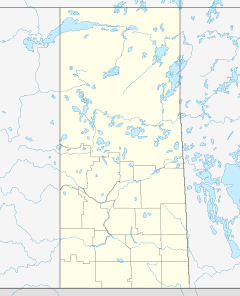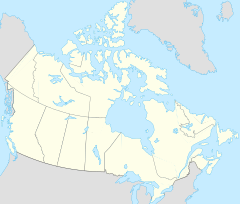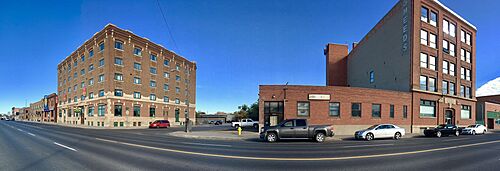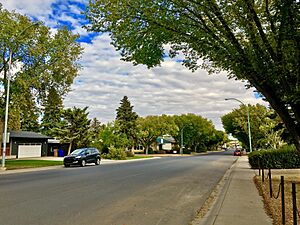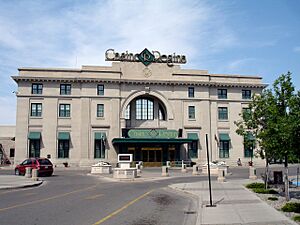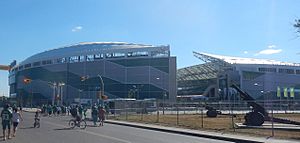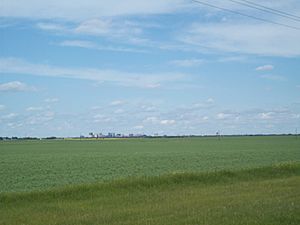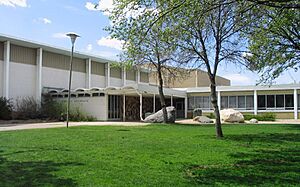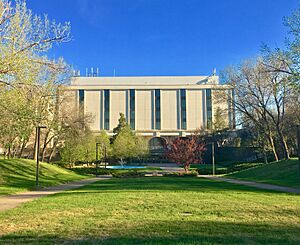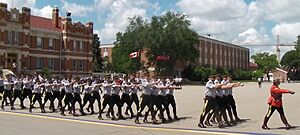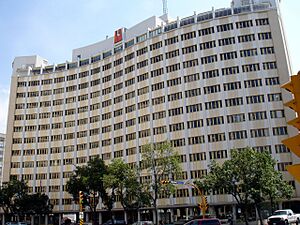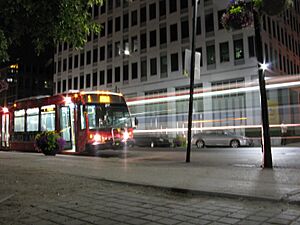Regina, Saskatchewan facts for kids
Quick facts for kids
Regina
|
|||||
|---|---|---|---|---|---|
|
City
|
|||||
| City of Regina | |||||
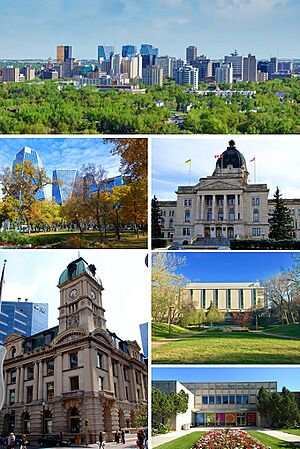
From top, left to right: Downtown Regina skyline, Victoria Park, Saskatchewan Legislative Building, Prince Edward Building, Dr. John Archer Library the Royal Saskatchewan Museum.
|
|||||
|
|||||
| Nickname(s):
"The Queen City"
|
|||||
| Motto(s):
Floreat Regina
("May Regina Flourish") |
|||||
| Country | Canada | ||||
| Province | Saskatchewan | ||||
| Rural municipality | Sherwood | ||||
| Established | 1882 | ||||
| Named for | Latin for "queen", named for Queen Victoria | ||||
| Area | |||||
| • City | 178.81 km2 (69.04 sq mi) | ||||
| • Metro | 4,323.66 km2 (1,669.37 sq mi) | ||||
| Elevation | 577 m (1,893 ft) | ||||
| Population
(2021)
|
|||||
| • City | 226,404 (ranked 24th) | ||||
| • Density | 1,266.2/km2 (3,279.32/sq mi) | ||||
| • Metro | 249,217 (ranked 18th) | ||||
| • Metro density | 57.6/km2 (149.3/sq mi) | ||||
| Demonym(s) | Reginan | ||||
| Gross Metropolitan Product | |||||
| • Regina CMA | CA$17.5 billion (2020) | ||||
| Time zone | UTC−06:00 (CST) | ||||
| Forward sortation area |
S4K – S4Z
|
||||
| Area code(s) | 306, 639, and 474 | ||||
| NTS Map | 72I7 Regina | ||||
| GNBC Code | HAIMP | ||||
Regina (pronounced ri-JEYE-nuh) is the capital city of Saskatchewan, a province in Canada. It's the second-largest city in Saskatchewan, right after Saskatoon. Regina is a busy place for business in southern Saskatchewan. In 2021, about 226,404 people lived in the city, and about 249,217 lived in the wider area around it. The city is run by the Regina City Council.
Regina used to be the main government spot for the Northwest Territories, which included what are now Saskatchewan and Alberta. The area was first called Wascana, which means "Buffalo Bones" in the Cree language. But in 1882, it was renamed Regina. This Latin word means "Queen," and it was chosen to honor Queen Victoria. Her daughter, Princess Louise, Duchess of Argyll, suggested the name.
Unlike many other cities built in the Canadian West, Regina is mostly flat and doesn't have many natural features, except for a small creek called Wascana Creek. Early city planners built a dam on this creek to create Wascana Lake, a beautiful lake south of the city center. Regina became even more important when it was made the capital of Saskatchewan in 1906. Today, Wascana Centre, which is built around Wascana Lake, is a major attraction. It includes the Saskatchewan Legislative Building, parts of the University of Regina, the Royal Saskatchewan Museum, and the Saskatchewan Science Centre.
Regina has many interesting neighborhoods. The old warehouse district north of the city center is now a popular spot for shops, restaurants, and homes. In 1912, a huge tornado hit the city, causing a lot of damage. Later, in the 1930s, the city faced tough times during the Great Depression. But since 2007, Saskatchewan's economy has grown strong again, thanks to its farms and natural resources.
Contents
History of Regina
How Regina Started (1882–1945)
Regina became the government center for the North-West Territories in 1882. The person in charge, Edgar Dewdney, chose this spot even though other places like Battleford had more buildings. The area was known as "Pile-of-Bones" because of the many bison bones found there. Princess Louise, the daughter of Queen Victoria, gave the new community the name Regina to honor her mother.
The city began to grow with wooden buildings and tents near the CPR train station. In 1885, Regina became well-known during the North-West Rebellion. The leader of the rebellion, Louis Riel, was tried and executed in Regina. This event brought a lot of attention to the young city.
Regina officially became a city on June 19, 1903. Just a few years later, on May 23, 1906, it was chosen as the capital of the new province of Saskatchewan. The impressive Saskatchewan Legislative Building was built between 1908 and 1912.
A terrible tornado, known as the "Regina Cyclone," hit the city on June 30, 1912. It was the deadliest tornado in Canadian history, killing 28 people. Regina grew quickly until the Great Depression started in 1929. During the 1930s, the city faced economic hardship. In 1935, Regina was also the site of the Regina Riot, a notable event during a march by unemployed workers.
Regina's Modern Times (1945–Present)

After 1945, many older department stores in downtown Regina closed or moved. This made the city center less busy. However, places like the Globe Theatre and Casino Regina helped bring people back downtown.
Sadly, many important old buildings were taken down between 1945 and 1970. For example, the old city hall was demolished in 1964. But since then, people have worked to save and reuse historic buildings.
In 1962, the Wascana Centre Authority was created to manage the huge park around Wascana Lake. A plan was made to develop the park, including a new campus for the University of Regina. This park has made Regina a more enjoyable place for everyone. Older buildings are now being used for new purposes, like the Canada Saskatchewan Production Studios. The Warehouse District has also become a popular area with shops, restaurants, and homes in old warehouses.
Regina's Geography
The city of Regina is located on a wide, flat plain with no trees. All of its trees, shrubs, and plants, about 300,000 of them, were planted by hand! Like other cities on the prairies, many American elm trees were planted in yards and along streets.
Newer neighborhoods have special landscaped ponds instead of regular storm sewers. However, the city's trees are now at risk from Dutch elm disease. The city has programs to control this disease and is planting new types of trees that are not affected.
Regina's Climate
Regina has warm summers and cold, dry winters. The weather can be extreme at any time of year. Most of the rain falls from May to August. The average temperature for the year is about 3.1 degrees Celsius. The coldest temperature ever recorded was -50.0 degrees Celsius on January 1, 1885. The hottest temperature ever was 43.9 degrees Celsius on July 5, 1937.
| Climate data for Regina International Airport, 1981–2010 normals, extremes 1883–present | |||||||||||||
|---|---|---|---|---|---|---|---|---|---|---|---|---|---|
| Month | Jan | Feb | Mar | Apr | May | Jun | Jul | Aug | Sep | Oct | Nov | Dec | Year |
| Record high °C (°F) | 10.4 (50.7) |
15.6 (60.1) |
24.4 (75.9) |
32.8 (91.0) |
37.2 (99.0) |
40.6 (105.1) |
43.9 (111.0) |
41.3 (106.3) |
37.2 (99.0) |
32.0 (89.6) |
23.6 (74.5) |
15.0 (59.0) |
43.9 (111.0) |
| Mean daily maximum °C (°F) | −9.3 (15.3) |
−6.4 (20.5) |
0.4 (32.7) |
11.6 (52.9) |
18.5 (65.3) |
22.8 (73.0) |
25.8 (78.4) |
25.5 (77.9) |
19.1 (66.4) |
11.0 (51.8) |
0.1 (32.2) |
−7.1 (19.2) |
9.3 (48.7) |
| Daily mean °C (°F) | −14.7 (5.5) |
−11.7 (10.9) |
−4.8 (23.4) |
4.8 (40.6) |
11.3 (52.3) |
16.2 (61.2) |
18.9 (66.0) |
18.1 (64.6) |
11.8 (53.2) |
4.3 (39.7) |
−5.2 (22.6) |
−12.4 (9.7) |
3.1 (37.6) |
| Mean daily minimum °C (°F) | −20.1 (−4.2) |
−17.0 (1.4) |
−9.9 (14.2) |
−2.0 (28.4) |
4.1 (39.4) |
9.5 (49.1) |
11.9 (53.4) |
10.7 (51.3) |
4.6 (40.3) |
−2.4 (27.7) |
−10.5 (13.1) |
−17.7 (0.1) |
−3.2 (26.2) |
| Record low °C (°F) | −50.0 (−58.0) |
−47.8 (−54.0) |
−40.6 (−41.1) |
−28.9 (−20.0) |
−13.3 (8.1) |
−5.6 (21.9) |
−2.2 (28.0) |
−5.0 (23.0) |
−16.1 (3.0) |
−26.1 (−15.0) |
−37.2 (−35.0) |
−48.3 (−54.9) |
−50.0 (−58.0) |
| Average precipitation mm (inches) | 15.3 (0.60) |
9.4 (0.37) |
19.7 (0.78) |
24.1 (0.95) |
51.4 (2.02) |
70.9 (2.79) |
66.9 (2.63) |
44.8 (1.76) |
32.8 (1.29) |
24.5 (0.96) |
14.2 (0.56) |
15.7 (0.62) |
389.7 (15.34) |
| Average rainfall mm (inches) | 0.6 (0.02) |
0.8 (0.03) |
5.1 (0.20) |
18.1 (0.71) |
47.6 (1.87) |
70.9 (2.79) |
66.9 (2.63) |
44.8 (1.76) |
32.1 (1.26) |
18.3 (0.72) |
3.1 (0.12) |
0.5 (0.02) |
308.9 (12.16) |
| Average snowfall cm (inches) | 19.4 (7.6) |
11.4 (4.5) |
18.8 (7.4) |
6.9 (2.7) |
3.6 (1.4) |
0.0 (0.0) |
0.0 (0.0) |
0.0 (0.0) |
0.7 (0.3) |
6.9 (2.7) |
13.0 (5.1) |
19.5 (7.7) |
100.2 (39.4) |
| Average precipitation days (≥ 0.2 mm) | 10.9 | 8.3 | 9.3 | 8.5 | 10.9 | 13.5 | 10.8 | 9.5 | 8.9 | 8.1 | 8.3 | 10.9 | 117.9 |
| Average rainy days (≥ 0.2 mm) | 0.85 | 0.77 | 2.5 | 6.3 | 10.5 | 13.5 | 10.8 | 9.5 | 8.7 | 6.1 | 1.7 | 1.0 | 72.3 |
| Average snowy days (≥ 0.2 cm) | 11.7 | 8.8 | 8.5 | 3.3 | 0.96 | 0.04 | 0.0 | 0.0 | 0.52 | 2.7 | 8.2 | 11.7 | 56.2 |
| Average relative humidity (%) | 76.1 | 76.4 | 69.5 | 44.5 | 42.9 | 48.3 | 48.8 | 45.4 | 45.5 | 52.4 | 68.2 | 75.7 | 57.8 |
| Mean monthly sunshine hours | 96.1 | 133.5 | 154.5 | 236.6 | 262.4 | 277.7 | 325.4 | 287.4 | 198.1 | 163.3 | 97.9 | 85.4 | 2,318.2 |
| Percent possible sunshine | 36.3 | 47.2 | 42.0 | 57.3 | 54.8 | 56.6 | 65.8 | 63.9 | 52.1 | 48.9 | 36.0 | 34.0 | 49.6 |
| Average ultraviolet index | 1 | 1 | 2 | 4 | 6 | 7 | 7 | 6 | 4 | 2 | 1 | 0 | 3 |
| Source: Environment Canada and Weather Atlas | |||||||||||||
Regina's Cityscape
Regina has several interesting neighborhoods:
- The original part of the city, located between the CPR tracks and Wascana Lake.
- The downtown business area, also called "Market Square."
- The Cathedral Area.
- The historic and wealthy Crescents area, just north of Wascana Creek.
- Germantown, which was originally home to many European immigrants.
- Lakeview, a neighborhood with large, impressive houses near the provincial government buildings.
- The Warehouse District, which used to be for storing goods. Now, it has cool shops, nightclubs, and homes.
Nearby Communities (Bedroom Communities)
Many people from Regina enjoy visiting the nearby Qu'Appelle Valley for holidays or even living there and driving to work in Regina. Over the years, some smaller towns near Regina lost people as farming changed.
However, thanks to good roads, some of these towns are now growing again as people choose to live there and commute to Regina. Places like White City, Emerald Park, Balgonie, Pilot Butte, and Lumsden are becoming like suburbs of Regina. Regina Beach, on Last Mountain Lake, is a popular summer spot and also a place where people live and commute from.
Regina's Culture
Regina has a lively arts scene, with lots of music, theater, and dance. The University of Regina helps support many artists. Famous artists like the Regina Five came from Regina College (now the university) in the 1950s. The MacKenzie Art Gallery has a large collection of art.
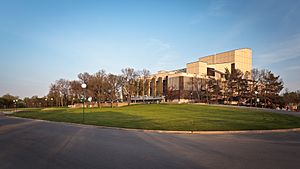
The Regina Symphony Orchestra is Canada's oldest orchestra that has been performing continuously. They play at the Saskatchewan Centre of the Arts (now the Conexus Arts Centre). You can also enjoy concerts and shows at the University of Regina. The Regina Conservatory of Music teaches music in an old building from Regina College.
The Regina Little Theatre started in 1926. For many years, Regina didn't have a big place for concerts and live theater. But in 1970, the Saskatchewan Centre of the Arts was built. It's known for its amazing sound quality and is home to the Regina Symphony Orchestra. The Royal Saskatchewan Museum opened in 1906. The old Post Office building is now home to the Globe Theatre, a professional theater company.

Regina hosts many annual festivals, including the Regina International Film Festival, the Cathedral Village Arts Festival, and the Regina Folk Festival. There's also Mosaic, a festival that celebrates different cultures. The annual Kiwanis Music Festival helps young musicians show their talent. The city's summer fair, now called the Queen City Ex, has been around since 1884.
The Regina Public Library has nine locations across the city. It offers movies, art exhibits at the Dunlop Art Gallery, and a collection of local history. The Saskatchewan Archives and the Saskatchewan Genealogical Library also have lots of information about the people of Saskatchewan.
Parks and Fun Places
Regina has many parks and green spaces, perfect for biking, cross-country skiing, and other fun activities. Wascana Lake is great for boating in the summer. In winter, it's cleared for ice skating. There are also hills for tobogganing. Victoria Park is in the middle of downtown.
The city has five golf courses. Kings Park Recreation facility has baseball fields and picnic areas. Just a short drive away, you can find summer cottages, camping spots, and winter ski resorts in the Qu'Appelle Valley.
Wascana Centre is a huge park, about 9.3 square kilometers, built around Wascana Lake. It was designed in 1961 by Minoru Yamasaki, who also designed the original World Trade Center in New York. Wascana Lake was first created in 1883 to provide water for trains.
Over time, the lake became a place for fun activities like swimming and boating. In 2003-2004, Wascana Lake was drained and deepened. They also added a new island, fountains, and a waterfall.
Places to Visit in Regina
Regina is a popular place to visit for people from southeastern Saskatchewan and nearby parts of the United States. Here are some top attractions:

- Wascana Centre: A large park with government buildings, fun activities, and cultural sites around Wascana Lake.
- Victoria Park: A downtown park that hosts festivals and a farmers market.
- Royal Saskatchewan Museum: A museum about natural history.
- Saskatchewan Science Centre: Located in an old power plant by Wascana Lake.
- Norman Mackenzie Art Gallery and other smaller galleries.
- Beautiful churches like the Roman Catholic cathedral and Knox-Metropolitan United Church.
- Hotel Saskatchewan: A historic hotel that has hosted royalty.
- RCMP national training center and museum: Learn about Canada's famous police force.
- Government House: You can take tours here.
- Casino Regina: Located in the old train station.
- Globe Theatre: A professional theater company in the old Post Office building.
- Mosaic Stadium and the Conexus Arts Centre: Places for sports and shows.
- REAL District (formerly Evraz Place): Home to the annual Queen City Ex summer fair and the Canadian Western Agribition agricultural show.
Regina's Sports
The Saskatchewan Roughriders of the Canadian Football League play their home games at Mosaic Stadium in Regina. This team, often called the "Riders," is owned by the community and has many loyal fans. They have won the Grey Cup four times: in 1966, 1989, 2007, and 2013. Regina also has a successful women's football team, the Regina Riot, who have won three league championships.
Other sports teams in Regina include the Regina Pats of the Western Hockey League, the Regina Thunder (junior football), and the Regina Red Sox (baseball). The University of Regina has its own sports teams, the Regina Cougars and Regina Rams. Regina is also a center for water polo in Saskatchewan.
Regina is well-known for its curling teams. The Richardson curling team was famous in the 1950s. More recently, Olympic Gold medalist Sandra Schmirler and her team brought great pride to the city. Regina has hosted the World Men's Curling Championship multiple times.
North-east of the city, Kings Park Speedway is a track for stock car racing. Regina has also hosted the Western Canada Summer Games twice and the Canada Summer Games in 2005.
Regina's People
| Historical populations | ||
|---|---|---|
| Year | Pop. | ±% |
| 1901 | 2,249 | — |
| 1911 | 30,213 | +1243.4% |
| 1921 | 34,432 | +14.0% |
| 1931 | 53,209 | +54.5% |
| 1941 | 57,389 | +7.9% |
| 1951 | 71,319 | +24.3% |
| 1961 | 112,141 | +57.2% |
| 1971 | 139,469 | +24.4% |
| 1976 | 149,593 | +7.3% |
| 1981 | 162,613 | +8.7% |
| 1986 | 175,064 | +7.7% |
| 1991 | 179,178 | +2.3% |
| 1996 | 180,404 | +0.7% |
| 2001 | 178,225 | −1.2% |
| 2006 | 179,246 | +0.6% |
| 2011 | 193,100 | +7.7% |
| 2016 | 215,106 | +11.4% |
| 2021 | 226,404 | +5.3% |
In 2021, Regina had a population of 226,404 people. This was a 5.3% increase from 2016. The larger Regina area, called the Census Metropolitan Area (CMA), had a population of 249,217.
Many people in Regina were born outside of Canada. In 2021, about 20.3% of the population were immigrants. The top countries they came from were the Philippines, India, and China.
Different Backgrounds in Regina
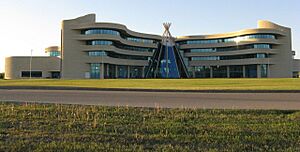
Regina has a diverse population. In 2021, about 10.4% of people in Regina identified as Indigenous. This includes First Nations and Métis people.
| Panethnic group |
2021 | 2016 | 2011 | 2006 | 2001 | |||||||||
|---|---|---|---|---|---|---|---|---|---|---|---|---|---|---|
| Pop. | % | Pop. | % | Pop. | % | Pop. | % | Pop. | % | |||||
| European | 142,440 | 63.85% | 150,110 | 70.88% | 149,225 | 78.65% | 147,955 | 83.63% | 150,515 | 85.71% | ||||
| Indigenous | 23,290 | 10.44% | 20,925 | 9.88% | 18,750 | 9.88% | 16,535 | 9.35% | 15,295 | 8.71% | ||||
| South Asian | 19,200 | 8.61% | 12,330 | 5.82% | 4,885 | 2.57% | 1,945 | 1.1% | 1,665 | 0.95% | ||||
| Southeast Asian | 15,525 | 6.96% | 11,060 | 5.22% | 6,635 | 3.5% | 2,445 | 1.38% | 2,175 | 1.24% | ||||
| African | 9,820 | 4.4% | 6,330 | 2.99% | 3,065 | 1.62% | 2,125 | 1.2% | 1,555 | 0.89% | ||||
| East Asian | 6,760 | 3.03% | 6,430 | 3.04% | 4,185 | 2.21% | 3,825 | 2.16% | 2,750 | 1.57% | ||||
| Middle Eastern | 2,920 | 1.31% | 2,275 | 1.07% | 1,060 | 0.56% | 700 | 0.4% | 475 | 0.27% | ||||
| Latin American | 1,410 | 0.63% | 1,180 | 0.56% | 1,270 | 0.67% | 955 | 0.54% | 770 | 0.44% | ||||
| Other/Multiracial | 1,700 | 0.76% | 1,140 | 0.54% | 670 | 0.35% | 425 | 0.24% | 400 | 0.23% | ||||
| Total responses | 223,070 | 98.53% | 211,780 | 98.45% | 189,740 | 98.26% | 176,910 | 98.7% | 175,605 | 98.53% | ||||
| Total population | 226,404 | 100% | 215,106 | 100% | 193,100 | 100% | 179,246 | 100% | 178,225 | 100% | ||||
| Note: Totals greater than 100% due to multiple origin responses | ||||||||||||||
Religions in Regina
According to the 2021 census, the main religious groups in Regina are:
- Christianity: 52.9%
- No religion: 35.4%
- Islam: 4.6%
- Hinduism: 2.9%
- Sikhism: 1.9%
- Buddhism: 0.8%
- Indigenous Spirituality: 0.5%
- Judaism: 0.2%
- Other religions: 0.7%
Regina's Economy
As the capital of Saskatchewan, Regina is home to many government offices and organizations. Several large provincial companies, called Crown Corporations, are also based here. These include SaskEnergy (gas), SGI (insurance), SaskPower (electricity), and SaskTel (phone and internet). The Innovation Place Research Park near the University of Regina has many science and technology companies.
Regina's economy relies a lot on oil, natural gas, and minerals like potash. When the train line reached Regina in 1885, it helped the city grow. Farming is still important, and Viterra Inc., one of the world's largest grain-handling companies, has its main office in Regina.
EVRAZ is a major company in Regina that makes steel plates and pipes. It started in 1956 as Prairie Pipe Manufacturing Company. Regina also has the Co-op Refinery Complex, which processes oil.
In the 1990s, some big companies moved their main offices to Regina, like Farm Credit Canada. While some companies have since moved parts of their operations, Regina remains an important business center.
Education in Regina
Schools for Kids and Teens
The Regina Public School Board runs 45 elementary schools and 9 high schools, with about 21,000 students. The Regina Catholic Schools Board operates 25 elementary schools and 4 high schools, with about 10,000 students. Both public and Catholic schools have modern science labs, gyms, and arts facilities. French-speaking public schools are run by the Conseil des écoles fransaskoises.
There are also some private schools, like Luther College, Regina Huda School, and Harvest City Christian Academy.
University of Regina
The University of Regina is the oldest university in the city, starting in 1911 as Regina College. It used to be connected to the University of Saskatchewan. In 1974, it became its own university.
Today, Campion College and Luther College are part of the University of Regina. The First Nations University of Canada is also connected to it. The Regina Research Park is next to the main campus, where companies work with university departments on projects in technology, oil, and environmental science.
Saskatchewan Polytechnic
The Regina campus of Saskatchewan Polytechnic is next to the University of Regina. It offers courses for trades, skilled jobs, and professional fields.
RCMP Training Academy
The RCMP Academy, known as "Depot" Division, is on the west side of Regina. It's where all RCMP officers get their training. Regina is proud of this national institution, which is a big attraction for visitors. You can watch sunset ceremonies and parades in the summer. The RCMP museum, called the RCMP Heritage Centre, opened in 2007.
Regina's Infrastructure
Regina gets its drinking water from Buffalo Pound Lake. This lake gets water from Lake Diefenbaker. Electricity is provided by SaskPower, a provincial company that uses coal, natural gas, hydroelectric, and wind power.
Medical services are available at three city hospitals: Regina General, Pasqua, and Wascana Rehabilitation Centre. Private doctors also provide care.
Police Services
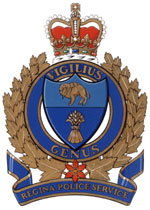
The Regina Police Service is the main police force for the city. It started in 1892 and has many officers and staff. Other police services, like the Royal Canadian Mounted Police, also work in the city.
Regina's Transportation
Getting Around the City
Regina Transit runs the city's public bus system. They have 110 buses that operate on 17 routes and 4 express routes, seven days a week. Regina used to have streetcars, but a big fire in 1949 destroyed many of them. This led to the city using diesel buses instead.
Major roads in the city include Ring Road, which helps connect different parts of the city quickly. The Regina Bypass is a larger highway that goes around the city.
Travel Between Cities
You can reach Regina by several highways, including the Trans-Canada Highway.
Regina International Airport serves Regina and the surrounding area. You can fly non-stop to major Canadian cities like Calgary, Edmonton, Toronto, Vancouver, and Winnipeg. There are also seasonal flights to places like Montreal, Las Vegas, and Mexico. The airport is the oldest commercial airport in Canada.
For bus travel, Rider Express provides service from Regina to other cities. Passenger train service stopped in Regina in 1990. The old train station in downtown Regina is now Casino Regina.
Regina's Media
Regina's daily newspaper is The Leader-Post, which started in 1883. There's also Prairie Dog, a free newspaper, and L'eau vive, a weekly newspaper in French.
Regina has many radio stations, including CKRM 620, CJME News/Talk 980, and CJTR-FM 91.3. There are also CBC radio stations in both English and French.
For television, Regina has four main channels: CKCK-TV (CTV), CBKT (CBC), CFRE-TV (Global), and CBKFT (SRC).
Regina's Sister Cities
Regina has special partnerships with other cities around the world to promote trade, culture, and education. These are called "twinning" or "friendship" agreements.
| City | Country | Date |
|---|---|---|
| Bucharest | Romania | 2011 |
| Jinan | China | 1987 |
| Fujioka | Japan | 2019 |
Famous People from Regina
See also
 In Spanish: Regina (Saskatchewan) para niños
In Spanish: Regina (Saskatchewan) para niños





